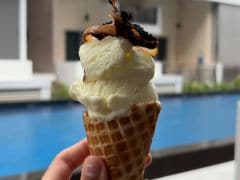Can you eat water? Yes! Leave it to the Japanese to introduce an extraordinary and unconventional creation to the world! Their ingenuity extends beyond technological breakthroughs to the realm of gastronomy, with a cake that looks like a water drop - raindrop cake! This gelatinous and wobbly dessert defies conventional expectations, resembling nothing like the usual fluffy cakes. Originating in Japan, this translucent treat adopts the shape of a raindrop, hence its moniker. Contrary to appearances, this isn't your typical gelatin dessert but rather an ultra-sensitive creation primarily consisting of water! This unique creation took the world (and the internet) by storm, with chefs giving it their unique creative touch.
Also Read: Viral Food Trend: How To Make Japanese Dora Cake?
Japanese raindrop cake is made with water.
Photo Credit: iStock
What is the raindrop cake called in Japan?
Contrary to appearances, this isn't your typical gelatin dessert but rather an ultra-sensitive creation primarily consisting of water. Known in Japanese as 'Mizu Shingen Mochi,' translating to 'the water cake,' it draws inspiration from the renowned Shingen mochi, distinguished by its incorporation of water sourced from Mount Kaikoma in the Southern Japanese Alps. It is said that the water from the Alps tastes delicious on its own.
Yet, don't let its delicate appearance fool you. This ephemeral dessert loses its form within a mere 30 minutes at room temperature, ensuring that every bite is a fleeting yet delightful experience that lingers on the taste buds.
What is the raindrop cake made of?
The star ingredient in this bouncy delicacy is agar, a vegan substitute for gelatin, combined with water. Served alongside roasted soybean flour (Kinako) and a sugary syrup (Kuromitsu), the raindrop cake, composed solely of water and agar, has gained popularity for being a guilt-free, low-calorie indulgence in Japan. Its lack of colour and elusive taste led to the practice of serving it with sweet and nutty accompaniments to enhance the overall flavour experience.
Also Read: Hold On, Have You Tried Cucumber Cheesecake? If Not, Then Make This Recipe Today!
The raindrop cake is often accompanied with other delightful sides.
Photo Credit: iStock
What does the Japanese raindrop cake taste like?
But what exactly is the flavour profile of a raindrop cake? Picture a mild and delicate texture that practically dissolves in your mouth. The agar and water amalgamation, solidified in moulds under refrigeration, remains neutral until the introduction of condiments. Paired with Kinako and Kuromitsu, each bite offers a subtle sweetness with a hint of smoky and roasted nutty undertones. The result is a uniquely satisfying culinary experience with a distinctly Japanese touch.
How is the Japanese raindrop cake made?
According to Britannica, the birth of the raindrop cake dates back to 2014 when the Kinseiken Daigahara confectioner in Hokuto introduced this unique creation using water sourced from the Japanese Alps, marketing it as "water you can eat." Moulded into a raindrop shape, it quickly garnered a fanbase, with eager visitors queuing up to relish its distinctive texture.
The process of bringing this transparent wonder to life is surprisingly straightforward. Agar, derived from algae and commonly employed to impart a jelly-like texture to liquids, is blended with water to facilitate solidification. The resulting water-agar mixture is then carefully poured into spherical moulds and left to set. The finished cake is placed at the centre of a dish and served with a delightful combination of roasted soybean powder (kinako) and black sugar syrup (kuromitsu).
Injecting an element of sophistication, chefs started incorporating edible flowers into the middle of the raindrop cake, levelling up this Japanese delicacy into a visually stunning feast for both the eyes and the palate.
Many chefs give creative touches to raindrop cake.
Photo Credit: iStock
So, the next time you find yourself yearning for a taste of Japan's innovative culinary landscape, seek out the captivating Mizu Shingen Mochi and immerse yourself in the enchanting experience of a raindrop cake. After all, who could resist the allure of a bite-sized serving of water?
